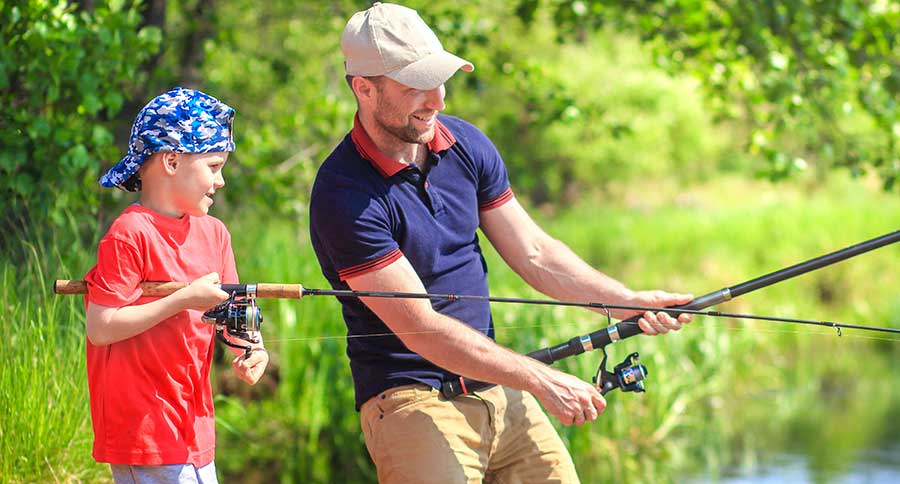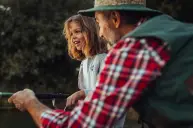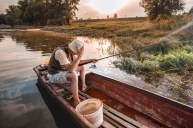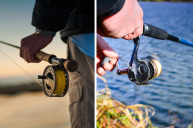It takes time and patience, but one of the greatest things that we can do is to teach a kid to fish.
Taking kids fishing can sometimes be a daunting task for veteran anglers who have already put their time in and are ready to spend the day being successful out on the water, but teaching a kid to fish is an even greater reward.
Many of us no longer think of a fishing trip in terms of using a bobber to catch panfish, or grabbing the trusty old cane pole to pull bluegill from the water, but it stands to reason that you know a kid that would love to try.
Getting the video games out of their hands and putting a fishing pole into them can be an exercise in futility, but the one thing that most kids will respond to is success.
It all starts with the proper fishing gear that will suit their size and ability while giving them the utmost opportunity to catch fish.
Teaching kids about knot tying, fishing line, and proper live bait use will come eventually, but getting them fish bites is the first order of business. Once they begin to pull fish out of the water, you'll have them hooked for life, pun intended!
1. Start Simple
A Spiderman rod may not be what you and I would use, but a kids style fishing pole might be the most fun in their young lives. If it has the likeness of their favorite super hero on it, so much the better.
It needs to be easy to use while also being dependable. Getting them a rod and reel combo of their choice is a great way to start them off, but nothing can be worse than if their rig fails at the wrong time and they lose a fish.
Here is where you need to choose the right fishing line wisely for them. It's not that you expect them to start right out catching lunkers. But you just don't want to be stuck with line that's constantly looping off of the reel creating knots that need constant untangling.
Surprisingly, a good quality braid (such as Power Pro) comes in very small diameter sizes, and a 150-yard spool can be used multiple times with multiple reels if you have more than one child ready to start fishing. It flies off of the reel and for the most part, it does not loop as long as you don't overfill the reel.
A good quality close-faced reel is where most kids start and rightly so. They are easy to use, almost fail free, and they will catch just about anything.
For those of us who started off with a Zebco, for instance, we will tell you they are what got us excited about fishing in the first place. Those first few casts that come right off of the reel and hit the water without landing right in front of a child is the first point of success. Certainly, you will have to teach them the proper technique, but the right gear will make it much easier for you.
Or course, let's not forget the most simple way there is: the cane pole. Being able to lift a bait and gently swing it into the water can get the youngest children fishing, and watching a bobber start to bounce and jerk will get any kid excited. You just have to make sure there are fish in the area.
2. Select a Can't-Miss Spot
If only we could do this searching for bass, walleye, or muskie, we might have gone pro by know.
Do your homework ahead of time: choose a bountiful panfishing spot where the worm will barely hit the water before it is eaten. They don't have to be sunfish or bluegill that fill the bucket for the frying pan, they just have to be fish that will bite and keep a kid occupied.
Here is where hook selection can be vital; keep it small, around size six and down to even a 10, with a longer shank. Something like the Aberdeen is easier to grab when sunk down in a panfish's mouth.
The best way to be prepared for the inevitable shallowed hook: don't let it happen in the first place by being vigilant. In lieu of that, have a good quality pair of needle nose pliers handy and either pinch the barbs or buy barbless hooks.
Farm ponds, park ponds, and even private ponds are the best bets for sitting on the bank with a kid. Part of your homework is to find access to these prime spots by asking the farmer or the property owner if you can take your kids fishing there.
For those with a boat, make sure to have the proper safety gear, sunscreen, and a fishing license where applicable. The adult almost certainly will need a license to take a kid fishing, even if they are not fishing themselves. Check your local regulations, and definitely look for free fishing days in your area.
3. Teach Kids to Find Their Own Bait
Teaching kids to catch their own bait is one of the most fun things that you can do. A simple walk down to the local creek to find crawfish or minnows is as satisfying as fishing itself. Show them how to identify areas where these creatures reside, such as under rocks for crayfish, or in the slow pools for minnows.
Maybe one of the most fun things you can do is to use a seine net to catch these baits. Raising a seine full of creatures that they may have never seen before is an education that they won't soon forget; baiting them on a hook and watching their reaction to hooking a lunker is one that won't leave your mind!
Probably these easiest to catch and easiest to get bait is right in your own backyard: the nightcrawler. Going outside after dark to find worms in the yard, especially after a rain, is as simple as it gets. Showing kids how to grab a slippery nightcrawler might even spark a good laugh out of them.
Maybe not every kid out there wants to grab a slimy worm or a wiggly minnow, but you're there for a reason. If they're still a bit squeamish about seeing their bait going onto the hook, then don't make them watch.
The bottom line is that catching bait is almost as fun as going fishing, including chasing grasshoppers around the garden or frogs down by the shore. The fun is in the trying, especially when they know that they are going fishing afterwards with bait that they caught by themselves.
4. Take Them to a Tackle Store
This might be an excuse to get yourself to the local tackle store, but a walk down the aisle where the kid's rod and reel combos are will likely get them excited. This might not be a time for an impromptu trip, but one you have planned ahead of time.
Letting them pick out their own lures, hooks, and line (ones that you lead them to) is a great way of getting your kids to see that their input counts. In other words, when they are on the way to or at the tackle store, knowing that mom and dad might buy something for them is better than receiving candy.
Bigger "tackle shops" have so much more to offer kids and even keep them entertained, such as their fully stocked fish aquariums. One look through that glass and they'll be intrigued, we can promise that!
I always liked to throw in a "How'd you like to hook that one?" when a big largemouth would swim by my son.
5. Preach Patience
And lots of it, because it's hard for them to have it.
Maybe the most important part of teaching young children to fish is this one thing. It is necessary to remember that you are not fishing, but your kids are. It's like the rules for youth hunting seasons in most states across the union: the adult can go, but cannot hunt, so just be there for them.
In other words, take the day off, because it's their turn. If you are trying to teach a kid to fish, you shouldn't be constantly turning your back to cast your favorite spinnerbait. It's not that you can't, it's just that you need to be a good teacher, and showing them how to be conscientious is a great thing as well.
Hopefully, at this point you have covered your bases and done the first four things on this list. Now its time to practice what you have been preaching.
Maybe the best thing to do is to have two people involved, like both parents for instance. Also, make sure to have some snacks and drinks that you know they like, which is another way to keep young hands busy while they are waiting for a strike.
Let them try anything, even something that you might find comical. Case in point: when my son was around six or seven he looked in my tackle box and decided that he wanted to use a Rat-L-Trap that was right on top. Not so odd, except that he insisted on using a bobber with it. He even caught a small bass while doing it!
Fishing is a great time for them to see that they can be in charge. Certainly, they will have to learn all the fishing regulations and safety rules before they can embark on their fishing adventure, but once they have been successful, they won't want to do anything else.
The reward for you and I? Well, there can be no greater reward than seeing a young person have the time of their lives and be successful doing it!
Looking for a little more? Follow my webpage, or on Facebook and Twitter.
NEXT: 3-YEAR-OLD HOOKS HUGE RAINBOW TROUT ON SPIDERMAN ROD
WATCH




